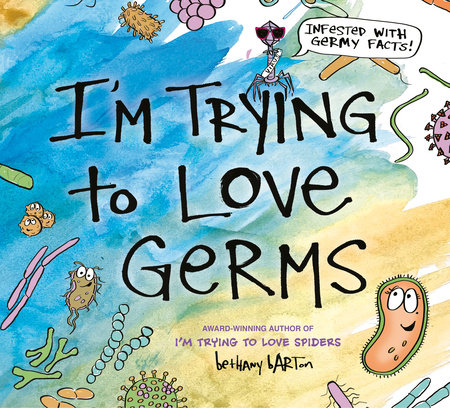Magnificent Microbes:
How to Talk to Your Kids About Germs
by Bethany Barton
Germs! They’ve got you covered (seriously). In the past few years, kids (and adults) have heard about germs and microbes more than ever. Wash your hands. Wear a mask. Keep your distance. Some of these messages can even seem a little, well… scary. Thankfully, microbes have been around even longer than people, so we’ve learned to live with them, and they’ve learned to live with us. We’re all in this together!
So, how do we help our kiddos develop a healthy understanding of the almost invisible world of microbes?
1) Meet Facts with Facts
As an author and illustrator of STEM books for kids — and as a mom — I’m often tasked with demystifying scary or uncomfortable subjects for kids. Stuff like spiders, bees, and even germs. To do so, I use a method I call “Meeting Facts with Facts.”
A favorite of mine: Yes, some spider bites can be fatal. However, (to meet a fact with a fact) fatal spider bites are so rare that you have a better chance of being struck by lightning!
There are many icky, illness-causing pathogens out there (pathogens are the microbes that can make us sick). But (to meet a fact with a fact) there are also billions of microbes in, on, and around us that do important stuff we need to survive. They help us digest our food or even edge out harmful microbes looking to move in.
So, it’s true, we’re surrounded! And that’s okay. Because most of the microbes in and around us are harmless, and some even do their best to help keep us happy and healthy. (Thanks, little guys!)
Kids are smart. When we empower them with facts, we take away a lot of the mystery — and, with that, a lot of their fears.
2) Help Out the Good Guys
Life is all about balance. Sure, we want to avoid pathogens, but we also want to protect our helpful microbes. After all, they’re on our side! So, how do we help establish and protect our beneficial buddies?
- Try new foods! Some foods are packed with more than flavor — they have helpful microbes, too! Foods like yogurt, pickles, miso, and kimchi can boost your gut microbiome. (“Microbiome” is a fancy word for a bunch of microbes living together in an environment).
- Play in the dirt! Studies have shown that getting out into nature and interacting with soil can expose us to an impressive variety of helpful microbes, including ones that can benefit our immune systems and even boost our moods!
3) Use Your Soapy Superpowers
Another way to empower kids? Remind them of a germ-fighting superpower they already have: hand-washing! Soap doesn’t just wash away the dirt we can see; it also zaps those pesky invisible pathogens.
But how does it work? Well, soap (and hand sanitizer) breaks down the cell walls of germs. I like to picture it like popping a water balloon. Are you ready for a fun experiment at home? Fill a water balloon* and plop it in your sink. Next, take a citrus peel (an orange or lemon peel will work well) and squeeze it as close as possible to the water balloon (you may even have to touch the balloon’s surface). A chemical reaction should make your balloon POP! Just like what soap does to those pesky pathogens. Germs can’t make you sick when they’re headed down the sink!
*Science note for grown-ups: This chemical reaction will only work with balloons that are not vulcanized (a fancy word for rubber treated with sulfur to strengthen it). So, party balloons and other chemistry-strengthened balloons won’t work. Water balloons are built-to-break, so they work well for this experiment. Just don’t let the rubbery balloon bits wash down the drain! YAY SCIENCE!
4) Think Like a Scientist
Microbes are hard to see without special equipment like a microscope. Try this fun experiment to help your mini-scientists visualize how many germs soap can eliminate:
- Grab some slices of bread and a few zip-lock bags. Have your kids rub their unwashed hands on one piece of bread and seal it into a bag. Label the bag with a marker so you know this bread met “dirty hands.”
- Next, have your kids wash their hands really well before they handle another piece of bread and seal it up. You can mark that bag “clean hands.”
- Leave these bags on your counter for a couple of weeks and see which one molds first — I bet you can guess! The dirty-hands bread will have a much more impressive display of mold.
- Bonus round: Rub a third piece of bread on someone’s cellphone or tablet — microbes love those things!
5) It’s a Small World After All
Kids and microbes have something in common — they’re both small but mighty! But with facts as our superpower, we’re all set to navigate this microscopic universe. Happy exploring!
-
Buy the Book:

